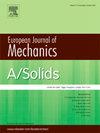Peridynamics modelling on corrosion fatigue behaviours of an iron-based alloy considering mechanochemical effects
IF 4.2
2区 工程技术
Q1 MECHANICS
引用次数: 0
Abstract
The fatigue failure process is significantly accelerated in the presence of corrosion, a phenomenon widely observed in engineering practice. Accurately predicting the corrosion fatigue behaviours of materials remains challenging owing to the limited knowledge of the synergic effects of corrosion and fatigue loads. This paper proposes a new peridynamic simulation method to analyze corrosion fatigue problems based on authors' previous work, which considers mechanochemical effects to exhibit coupling between corrosion and material deformations. To validate the reasonability of the proposed method, corrosion fatigue tests on an iron-based (Fe-based) alloy are conducted to acquire experimental benchmarks. Then, numerical simulations based on the proposed method are conducted, whose results are compared with testing results, also simulation results obtained by previous simulation method. The proposed method not only provides accurate predictions on corrosion fatigue properties (the simulated fatigue limit is 249 MPa, the same with the tested one), but also increases accuracy on lifetime predictions by 66 % compared with authors’ previous work. The proposed method not only provides a unified simulation method in dealing with complex mechanical problems considering both continuity and discontinuity, such as corrosion fatigue, but also provides good accuracy in predictions of corrosion fatigue properties, making such method both theoretical-meaningful and engineering-practical.
考虑力学效应的铁基合金腐蚀疲劳行为的周动力学建模
在工程实践中广泛观察到的一种现象是,腐蚀的存在显著加速了疲劳破坏过程。由于对腐蚀和疲劳载荷协同作用的认识有限,准确预测材料的腐蚀疲劳行为仍然具有挑战性。本文在前人工作的基础上,提出了一种新的腐蚀疲劳模拟方法,该方法考虑了材料变形与腐蚀之间的力学化学耦合效应。为了验证所提方法的合理性,对铁基(铁基)合金进行了腐蚀疲劳试验,获得了试验基准。然后,基于该方法进行了数值仿真,并将仿真结果与试验结果以及以往仿真方法得到的仿真结果进行了比较。该方法不仅能准确预测腐蚀疲劳性能(模拟疲劳极限为249 MPa,与试验值相同),而且寿命预测精度比以往提高了66%。该方法不仅为处理诸如腐蚀疲劳等既考虑连续性又考虑非连续性的复杂力学问题提供了统一的模拟方法,而且对腐蚀疲劳性能的预测具有较高的准确性,具有理论意义和工程实用价值。
本文章由计算机程序翻译,如有差异,请以英文原文为准。
求助全文
约1分钟内获得全文
求助全文
来源期刊
CiteScore
7.00
自引率
7.30%
发文量
275
审稿时长
48 days
期刊介绍:
The European Journal of Mechanics endash; A/Solids continues to publish articles in English in all areas of Solid Mechanics from the physical and mathematical basis to materials engineering, technological applications and methods of modern computational mechanics, both pure and applied research.

 求助内容:
求助内容: 应助结果提醒方式:
应助结果提醒方式:


